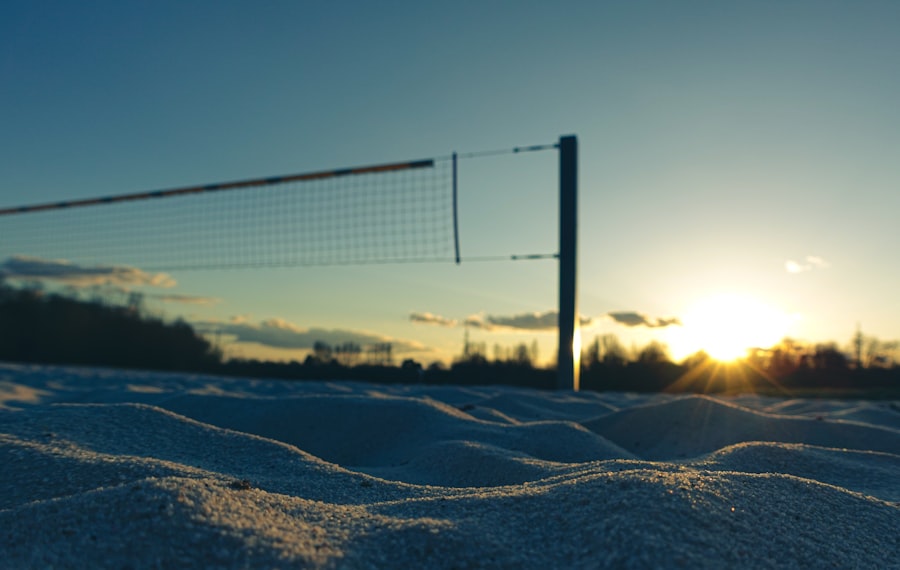Mastering the Art of Volleyball: Tips for Success
Description
Volleyball is a dynamic and fast-paced sport that has captivated millions around the globe. Originating in the United States in 1895, it has evolved into a highly competitive game played both indoors and on the beach. The fundamental objective of volleyball is simple: two teams, typically consisting of six players each, aim to score points by sending a ball over a net and landing it within the opposing team’s court.
The game is played in sets, with teams needing to reach a predetermined number of points, usually 25, to win a set, and the first team to win three sets is declared the victor.
43 meters high for men and 2.24 meters for women. Each team has three front-row players and three back-row players, with specific roles that contribute to both offensive and defensive strategies.
The rotation system ensures that all players participate in various positions throughout the match, enhancing their versatility and understanding of the game. The rules governing volleyball are designed to promote fair play and sportsmanship, with violations such as net touches or foot faults leading to point deductions for the offending team.
Key Takeaways
- Volleyball is a team sport played with six players on each side, aiming to score points by grounding the ball on the opponent’s court.
- Essential skills for success in volleyball include passing, setting, attacking, serving, and blocking.
- Mastering serve and serve receive techniques is crucial for controlling the game and putting pressure on the opponent.
- Improving defensive and blocking strategies involves proper positioning, reading the opponent’s attacks, and effective blocking at the net.
- Enhancing offensive strategies and hitting techniques require strong communication, quick decision-making, and powerful hitting to score points.
Developing Essential Skills for Success
The Foundation of Effective Play: Passing
Passing is often considered the foundation of effective play; it allows teams to maintain possession of the ball and set up offensive plays. A well-executed pass can lead to a successful attack, while poor passing can disrupt the flow of the game.
The Playmaker: Setting
Setting is another critical skill that requires precision and timing. The setter acts as the playmaker, determining which hitter will receive the ball based on the positioning of both teammates and opponents. A skilled setter must possess excellent hand-eye coordination and an acute awareness of the game’s dynamics.
Scoring Points: Hitting
Hitting, or attacking, involves striking the ball with power and accuracy to score points. This skill requires not only physical strength but also an understanding of angles and timing to outmaneuver blockers. As players develop these essential skills, they also learn to communicate effectively with teammates, fostering a cohesive unit capable of executing complex strategies.
Mastering Serve and Serve Receive Techniques

The serve is one of the most critical components of volleyball, as it initiates each rally and can set the tone for the entire match. There are various types of serves, including underhand, overhand, float serves, and jump serves, each requiring different techniques and levels of skill. The overhand serve is particularly popular among advanced players due to its potential for power and placement.
Mastering this serve involves proper footwork, body positioning, and follow-through to ensure maximum velocity and accuracy. On the receiving end, serve receive techniques are equally vital for establishing control over the game. Players must be adept at reading the server’s body language and anticipating the trajectory of the ball.
Effective serve receive strategies often involve forming a solid formation that allows for quick adjustments based on the server’s actions. Players typically use a platform passing technique to create a stable surface for receiving serves, ensuring that they can direct the ball accurately to the setter. Practicing these techniques consistently can significantly enhance a team’s ability to respond effectively to various serving styles.
Improving Defensive and Blocking Strategies
| Defensive and Blocking Strategies | Metrics |
|---|---|
| Blocks per game | 2.5 |
| Defensive rebounds per game | 8.3 |
| Steals per game | 1.7 |
| Opponent field goal percentage | 42% |
Defense in volleyball is multifaceted, encompassing both individual skills and team strategies designed to thwart opposing attacks. One of the primary defensive techniques is digging, which involves players using their bodies to prevent the ball from hitting the ground after an opponent’s attack. This skill requires quick reflexes and an understanding of where to position oneself on the court to maximize coverage.
Players often practice digging drills that focus on reaction time and body positioning to improve their effectiveness in this area.
Successful blocking requires timing, anticipation, and coordination among teammates.
Players must learn to read the hitter’s approach and jump at the right moment to create an effective barrier against spikes. Additionally, communication is crucial during blocking; players must call out their intentions and coordinate their movements to avoid gaps in defense. By honing these defensive skills and strategies, teams can significantly reduce their opponents’ scoring opportunities.
Enhancing Offensive Strategies and Hitting Techniques
Offensive strategies in volleyball are designed to maximize scoring opportunities while minimizing errors. A well-executed offense relies on effective communication among players, as well as a deep understanding of each player’s strengths and weaknesses. Teams often employ various formations and plays to keep opponents guessing and create mismatches at the net.
For example, running quick sets can catch blockers off guard, allowing hitters to exploit openings in the defense. Hitting techniques are integral to executing offensive strategies successfully. Players must develop a powerful swing that combines speed with precision.
This involves proper footwork to approach the ball effectively, as well as utilizing body mechanics to generate force during the attack. Different types of hits—such as line shots, cross-court shots, and tips—allow hitters to adapt their approach based on defensive positioning. Additionally, understanding how to read blockers can provide valuable insights into where to place attacks for maximum effectiveness.
Continuous practice of these techniques enables players to refine their offensive capabilities and contribute significantly to their team’s success.
Mental and Physical Preparation for Peak Performance

Building Confidence and Reducing Anxiety
This mental rehearsal helps build confidence and reduces anxiety during high-stakes moments. By visualizing success, athletes can develop a winning mentality that translates to real-life performance.
Physical Preparation for Volleyball
Physical preparation encompasses various aspects such as strength training, conditioning, and flexibility exercises tailored specifically for volleyball players. Strength training focuses on developing core muscles essential for jumping and stability during play. Conditioning drills enhance endurance, allowing players to maintain high levels of performance throughout long matches.
Optimizing Performance through Integrated Training
Flexibility exercises are crucial for preventing injuries and improving overall agility on the court. By integrating mental strategies with physical training regimens, athletes can optimize their performance levels and contribute positively to their team’s success in competitive environments.
If you’re a fan of volleyball, you may also be interested in reading about the latest gaming sensation, Farlight 84. This futuristic battle royale game has been gaining popularity since its release in 2023. Check out this article to learn more about the exciting gameplay and unique features of Farlight 84.
FAQs
What is volleyball?
Volleyball is a team sport in which two teams of six players are separated by a net. The objective is to score points by grounding the ball on the opposing team’s court.
What are the basic rules of volleyball?
The basic rules of volleyball include serving the ball over the net, rallying to keep the ball in play, and trying to score points by grounding the ball on the opposing team’s court. Each team is allowed three touches to return the ball.
What are the different types of volleyball games?
There are several variations of volleyball, including indoor volleyball, beach volleyball, and sitting volleyball. Each variation has its own set of rules and regulations.
What equipment is needed to play volleyball?
The main equipment needed to play volleyball includes a volleyball, a net, and appropriate footwear. Players also typically wear knee pads and may use other protective gear.
What are the health benefits of playing volleyball?
Playing volleyball can provide a range of health benefits, including improved cardiovascular fitness, increased muscle strength and endurance, and enhanced coordination and agility. It also promotes teamwork and social interaction.
What are the key skills needed to play volleyball?
Key skills needed to play volleyball include serving, passing, setting, attacking, blocking, and digging. Players also need good communication and teamwork skills.





